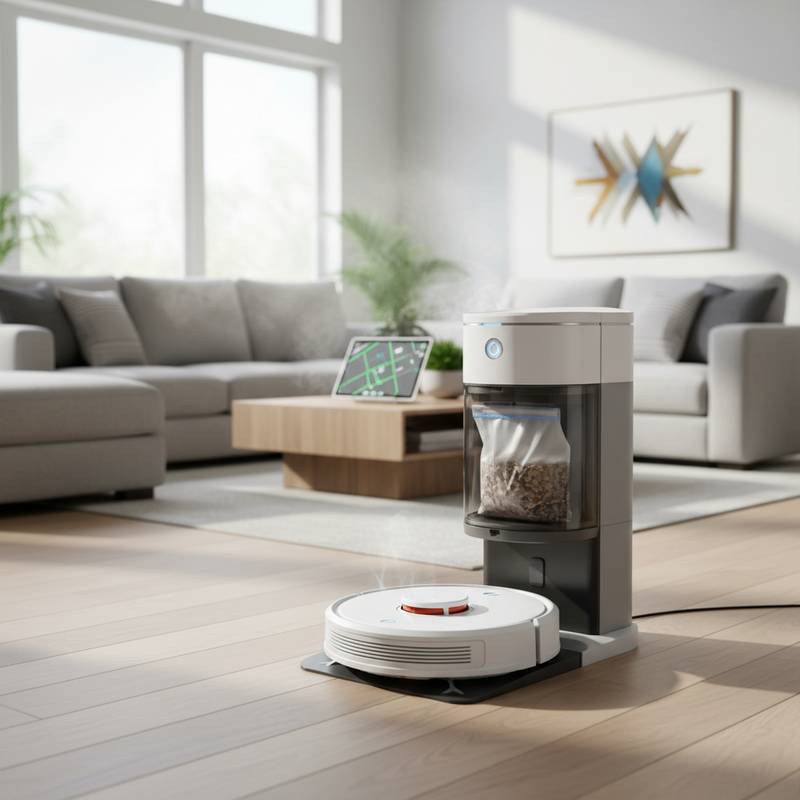Self-Emptying Robot Vacuums: Effortless Cleaning for Weeks
The Evolution of Autonomous Cleaning
Picture completing your evening meal and settling in for entertainment while a subtle hum echoes from the corridor. The robot vacuum has completed its task, returned to the charging station, and disposed of its collected debris independently. This seamless process, once confined to speculative narratives, now represents the forefront of intelligent home appliances.
In numerous residences, the task of emptying the dustbin remained the primary barrier to complete automation. Accumulated crumbs, pet fur, and microscopic particles often led to overflows during extended use. Contemporary self-emptying robot vacuums address this issue through sophisticated waste handling mechanisms, rendering the cleaning process almost entirely independent.
Achieving Genuine Autonomy in Home Maintenance
Initial generations of robot vacuums simplified daily routines yet required regular intervention. Users needed to clear the compact internal container after just a few sessions, preventing a fully unattended operation. The breakthrough arrived with the integration of robust suction capabilities and docking stations designed for automatic debris transfer into enclosed receptacles.
This advancement allows the device to operate for several weeks without manual involvement. For households with demanding schedules, pets, or individuals prone to allergies, such functionality proves revolutionary. The result extends beyond time savings; it fosters a consistently hygienic living space with minimal personal effort.
Mechanics of Self-Emptying Systems
The configuration appears straightforward, yet it incorporates sophisticated technology. Upon returning to the dock, alignment sensors position the vacuum precisely against the station's intake port. A dedicated suction mechanism in the base then extracts contents from the robot's bin into an expansive bag or reservoir.
Typical docking units accommodate waste from 20 to 60 cycles before requiring attention. Certain variants feature automatic sealing to contain allergens, enhancing appeal for environments with respiratory sensitivities.
Key Insight: Optimizing Dock Ventilation
An often overlooked element is the ventilation configuration within the docking station, which significantly influences performance. Entry-level units may rely on a solitary intake pathway, prone to obstructions from strands of hair or sizable particles. Higher-end designs employ parallel ventilation routes with strategically oriented outlets, minimizing jams and prolonging component durability. This nuance substantially impacts overall dependability.
Evaluating Choices Across Price Tiers
The market provides compelling selections at various budgets for those prepared to upgrade.
-
Entry-Level Pick: Shark Matrix Self-Empty Robot Vacuum
Estimated cost: $399
This unit delivers dependable navigation and a self-emptying dock capable of retaining debris for up to 30 days. It omits sophisticated barrier detection, yet it excels in compact spaces such as apartments. -
Intermediate Option: Roborock Q Revo
Estimated cost: $899
The Q Revo distinguishes itself by combining dry and wet cleaning functions. Beyond dust evacuation, the base cleans and air-dries the mopping attachments. This comprehensive approach suits those seeking enhanced coverage without premium expenditure. -
High-End Recommendation: iRobot Roomba Combo j9+
Estimated cost: $1,399
This elite device incorporates exact mapping, item identification, and an airtight disposal system. It adapts to surface types by elevating the mop on carpets. The enclosed bags effectively capture ultrafine particles, positioning it as a leader in allergen mitigation.
Integration Factors
Contemporary self-emptying models seamlessly connect with ecosystems including Alexa, Google Home, and Apple HomeKit. During selection, verify app-based firmware update support. These enhancements refine navigation precision and optimize cleaning patterns over time.
Essential Factors for Purchase Decisions
Prior to acquisition, evaluate positioning and upkeep requirements. The docking station demands proximity to an electrical outlet and unobstructed access for recharging. Steer clear of placements near dense carpets or overhanging fixtures that might impede docking.
Initial setup typically spans 15 minutes, encompassing application configuration and home scanning. The device conducts an initial exploration to generate a detailed layout. Subsequently, users can program zone-specific sessions or activate routines via verbal instructions.
Ongoing Expenses and Upkeep
Disposable bags for the base generally cost $15 per three-pack. Air filters and rotating brushes necessitate replacement every few months, scaled to frequency of use. These routine costs ensure sustained optimal function.
For those avoiding disposables, select units with reusable reservoirs. Such alternatives demand more hands-on clearing but remove ongoing supply purchases.
Performance and Security Features
Confirm the presence of thermal safeguards in the dock. Powerful motors generate heat risks if pathways clog. Established manufacturers incorporate shutdown protocols, though reviewing technical details remains prudent.
Integrating Autonomous Cleaning into Daily Life
Adopting a self-emptying robot vacuum reshapes perspectives on domestic responsibilities. Cleaning shifts to a peripheral activity, with surfaces maintaining neatness effortlessly. Maintenance concerns diminish, allowing focus on other priorities.
In the broader scope, consistent operation preserves flooring integrity. Routine removal of gritty residues averts surface degradation, particularly on wood and ceramic materials. The periodic sound of the unit returning to base serves as a subtle affirmation of proactive home management.
Next Steps for Smarter Home Automation
To advance your cleaning setup, assess current needs against available models. Begin with a trial mapping in your space to gauge compatibility. This investment in technology yields lasting efficiency and peace of mind.
